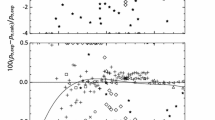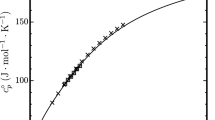Abstract
The modern fundamental equations of state are analyzed together with methods of applying them for calculating the thermodynamic properties of technically important substances. Two kinds of fundamental equations of state (with 12 and 14 terms) are obtained for normal undecane (n-undecane), which is a technically important organic working substance.
Similar content being viewed by others

References
R. Span, Multiparameter Equation of State: An Accurate Source of Thermodynamic Property Data (Springer, Berlin, 2000).
D. S. Kurumov, The Thermal Properties of n-Alkanes and Fractions of Mangyshlak Petroleum in Liquid and Gaseous States, Doctoral Dissertation in Technical Sciences (Grozny Petroleum Institute, Grozny, 1991).
K. N. Marsh, R. C. Wilhoit, M. Frenkel, and D. Yin, TRC Thermodynamic Properties of Substances in the Ideal Gas State (Thermodynamics Research Center, 1994).
L. Sun and J. E. Ely, “Universal Equation of State for Engineering Application: Algorithm and Application,” Fluid Phase Equilibria 222–223, 107–118 (2004).
R. Fletcher, A Modified Marquardt Subroutine for Non-Linear Least Squares, (Atomic Energy Research Establishment, Harwell, Berkshire (R.6799), May 1971), pp. 1–24.
E. W. Lemmon and R. T. Jacobsen, “A New Functional Form and New Fitting Techniques for Equations of State with Application to Pentafluoroethane (HFC-125),” J. Phys. Chem. Ref. Data 34(1), 6–108 (2005).
F. Krafft, “On Nineteen Higher Normal Paraffins and a Simple Volume Law for Liquids That Form Drops. I,” Ber. Dtsch. Chem. Ges. 15(1), 1687–1711 (1882).
C. Viton, M. Chavret, E. Behar, and J. Jose, “Vapor Pressure of Normal Alkanes from Decane to Isosane at Temperatures from 244 K to 469 K and Pressures from 0.4 Pa to 164 kPa,” Int. Electron. J. Phys. Chem. Data 2, 215–224 (1996).
I. S. Aleksandrov, A. A. Gerasimov, and E. B. Grigor’ev, “Evaporation Enthalpy and Saturated Vapor Pressure of C5-C18 n-Alkanes Near the Triple Point,” Obor. Kompl. Nauchno-Tekhn. Progr. Rossii, No. 4, 56–61 (2010).
P. A. Chmykhalo, DSSDD (Ukrainian State Standard) 7-2005: The Procedure for Calculating the Saturated Vapor Pressure of n-Alkanes (C 1-C 100 ) and Hydrogen on the Boiling Line (Derzhspozhivstandard Ukrainy, Kiev, 2005).
J. S. Stadnicki, “Tonometric Investigations of Binary and Ternary Azeotropes. IV. Binary System Aniline-n-Undecane,” Bull. Acad. Polon. Sci., Ser. Sci. Chem. 10, 299–301 (1962).
E. C. Bingham and H. J. Fornwalt, “Chemical Constitution and Association,” J. Rheology 1(4), 372–417 (1930).
R. W. Dornte and C. P. Smyth, “The Dielectric Polarization of Liquids. X. The Polarization and Refraction of the Normal Paraffins,” J. Amer. Chem. Soc. 52, 3546–3552 (1930).
G. Calingaert, H. A. Beatty, R. C. Kuder, and G. W. Thomson, “Homologous Series of Alkanes Density and Its Temperature Coefficient,” Ind. and Eng. Chem. 33(1), 103–106 (1941).
O. R. Quayle, R. A. Day, and G. M. Brown, “A Study of Organic Parachors. VII. A Series of Saturated Hydrocarbons,” J. Amer. Chem. Soc. 66, 938–941 (1944).
A. I. Vogel, “Physical Properties and Chemical Constitution. Part IX. Aliphatic Hydrocarbons,” J. Chem. Soc. 146, 133–139 (1946).
A. K. Doolittle and R. H. Peterson, “Preparation and Physical Properties of a Series of n-Alkanes,”J. Amer. Chem. Soc. 73, 2145–2151 (1951).
A. K. Doolittle, “Specific Volumes of n-Alkanes,” J. Chem. Eng. Data 9(2), 275–279 (1964).
D. L. Camin and F. D. Rossini, “Physical Properties of 14 American Petroleum Institute Research Hydrocarbons, C(9) to C(15),” J. Phys. Chem. 59(11), 1173–1179 (1955).
J. A. Dixon, “Phase Equilibria Molecular Transport Thermodynamics. Part I. Binary Solutions of Saturated Hydrocarbons,” J. Chem. Eng. Data 4(4), 289–294 (1959).
V. G. Ben’kovskii, M. K. Naurusov, T. M. Bog- oslovskaya, and Z. Serikov, “Density of Binary Mixtures of n-Alkanes,” Trans. Inst. Khim. Neft. Prir. Solei, Akad. Nauk Kaz. SSR, No. 1, 16–19 (1970).
J. G. Hust and R. E. Schramm, “Density and Crystallinity Measurements of Liquid and Solid n-Undecane, n-Tridecane, and o-Xylene from 200 to 350 K, J. Chem. Eng. Data 21(1), 7–12 (1976).
P. M. Diaz and G. Tardajos, “Isothermal Compressibilities of n-Alkanes and Benzene,” J. Chem. Thermodyn. 10(1), 19–24 (1978).
R. Landau and A. Wuerflinger, “PVT Data of Acetonitrile, Undecane, and Dodecane to 3 kbar and −50°C. Pressure Dependence and Change of Volume, Enthalpy, and Entropy,” Ber. Bunsenges. Phys. Chem. 84, 895–902 (1980).
M. Garcia, C. Rey, V. P. Villar, and J. R. Rodrigues, “Excess Volumes of (n-Heptane + n-Undecane) between 288.15 and 308.15 K,” J. Chem. Thermodyn. 18(6), 551–554 (1986).
L. D. Mansker, A. C. Criser, A. Jangkamolkulchai, and K. D. Luks, “The Isothermal Compressibility of n-Paraffin Liquids at Low Pressures,” Chem. Eng. Comm. 57(6), 87–93 (1987).
J. Ortega, J. S. Matos, J. A. Pena, et al., “Isobaric Expansivities of the Binary Mixtures C3H7(OH) + CnH2n + 2 (n = 11, 12) between 288.15 and 318.15 K,” Thermochim. Acta 131(12), 57–64 (1988).
J. Wu, Z. Shan, and A.-F.A. Asfour, “Viscometric Properties of Multicomponent Liquid n-Alkane Systems,” Fluid Phase Equilib. 143(12), 263–274 (1998).
L. M. Casas, A. Tourino, B. Orge, et al., “Thermophysical Properties of Acetone or Methanol + n-Alkane (C9 to C12) Mixtures,” J. Chem. Eng. Data 47(4), 887–893 (2002).
I. S. Aleksandrov and A. A. Gerasimov, “The Thermal Properties of Normal Undecane on the Saturation Line,” in Proceedings of the Seventh International Conference “Innovations in Science and Education-2009,” KGTU, Kaliningrad, 2009, pp. 65–67.
H. M. Huffman, G. S. Parks, and M. Barmore, “Thermal Data on Organic Compounds. X. Further Studies on the Heat Capacities, Entropies, and Free Energies of Hydrocarbons,” J. Amer. Chem. Soc. 53(10), 3876–3888 (1931).
H. L. Finke, M. E. Gross, G. Waddington, and H. M. Huffman, “Low-Temperature Thermal Data for the Nine Normal Paraffin Hydrocarbons from Octane to Hexadecane,” J. Amer. Chem. Soc. 76(2), 333–341 (1954).
A. A. Gerasimov, The Caloric Properties of Normal Alkanes and Multicomponent Hydrocarbon Mixtures in Liquid and Gaseous Phases Including the Critical Region, Doctoral Dissertation in Technical Sciences (KGTU, Kaliningrad, 1999).
V. Majer and V. Svoboda, Enthalpies of Vaporization of Organic Compounds. A Critical Review and Data Compilation (Blackwell Sci. Publ., Oxford, 1985).
E. Moravetz, “A Non-Equilibrium Low Vapor Pressure Heat of Vaporization Calorimeter,” Acta Chem. Scand. 22(5), 1509–1531 (1968).
A. Z. Golik and I. I. Ivanova, “The Molecular Structure, Density, Compressibility, and Viscosity of n-Alkanes in Liquid State,” Zh. Fiz. Khim. 36(12), 1768–1770 (1962).
Yu. A. Neruchev, V. V. Zotov, and N. F. Otpushchenkov, “Speed of Sound in the Homologous Series of n-Alkanes,” Zh. Fiz. Khim. 43(11), 1597–1599 (1969).
Yu. F. Melikhov, “Studying the Temperature and Baric Dependences of Ultrasound Velocity in Polyatomic Liquids,” in Ultrasound and Thermodynamic Properties of Substance (Kursk Gos. Ped. Inst., Kursk, 1985), pp. 81–103.
G. Tardajos, M. D. Pena, and E. Aicart, “Speed of Sound in Pure Liquids by a Pulse-Echo-Overlap Method,” J. Chem. Thermodyn. 18(7), 683–689 (1986).
F. Plantier, J.-L. Daridon, B. Lagourette, and C. Boned, “Isoentropic Thermophysical Properties of Pure n-Paraffins as a Function of Temperature and Chain Length,” High Temp. High Press. 32(3), 305–310 (2000).
Author information
Authors and Affiliations
Additional information
Original Russian Text © I.S. Aleksandrov, A.A. Gerasimov, B.A. Grigor’ev, 2011, published in Teploenergetika.
Rights and permissions
About this article
Cite this article
Aleksandrov, I.S., Gerasimov, A.A. & Grigor’ev, B.A. Using fundamental equations of state for calculating the thermodynamic properties of normal undecane. Therm. Eng. 58, 691–698 (2011). https://doi.org/10.1134/S0040601511080027
Published:
Issue Date:
DOI: https://doi.org/10.1134/S0040601511080027



